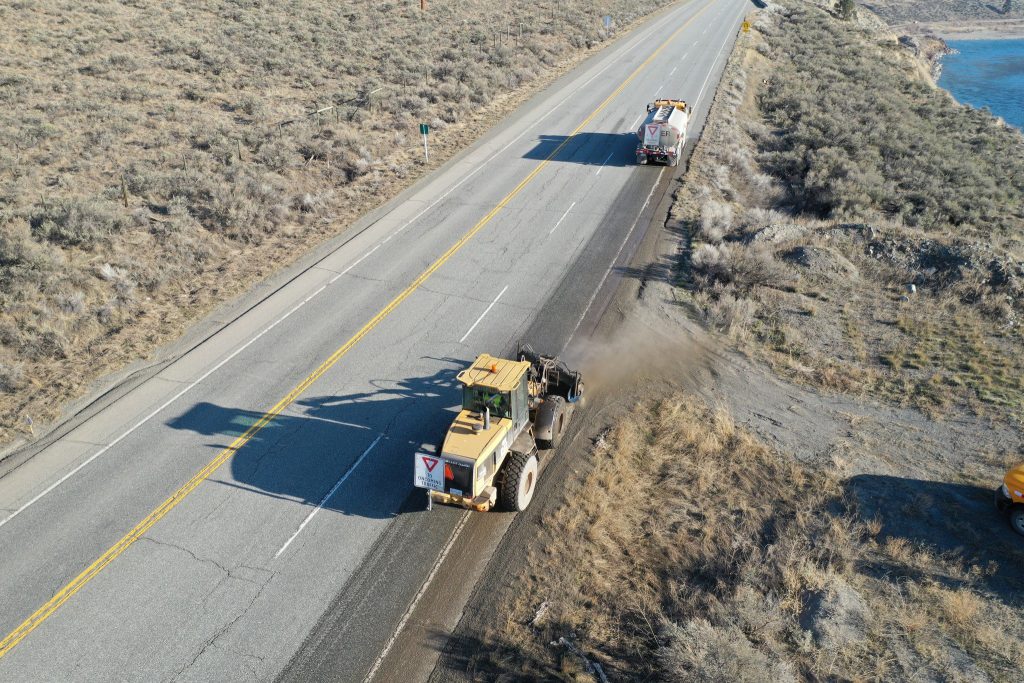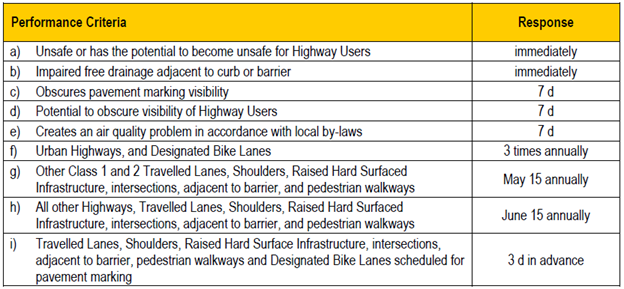
Dirt sand stones tremble
Hear the sweeper truck rumble
Spring makes way for smooth
- A TranBC spring road maintenance haiku
An active sweeper truck is as welcome a sign of spring as any blooming BC flower. And although the sweeper’s bulky stature may not please the eye like your average daffodil or tulip, nothing looks as satisfyingly fresh as a newly swept surface after highway sweeping.
Our highway maintenance contractors sweep a whopping 66,000 lane kilometres of road every year across the province. That’s like going around the circumference of the Earth one and a half times (and then some). In other words, that’s a LOT of dirt, sand and other bits of debris collected or pushed out of the way for travellers.
Contract Requirements
Maintenance contractors are required to sweep roads in their service area based on specific performance criteria. Here it is at a glance:

The performance criteria takes into account both yearly sweeping routines and circumstances that require a specific response time. For example, you’ll notice urban highways and designated bike lanes must be swept three times annually. However, debris that is unsafe or has the potential to be unsafe must be cleared immediately.
Of course, sweeping timelines and routines differ depending on the service area. Maintenance contractors in the milder South Coast region typically sweep throughout the year, while contractors in snowier Interior climates will be more active through the spring and summer, when things are thawed and there is a strong need to clear winter abrasives.
How Sweeping Works
The type of sweeping equipment used depends on the type of surface being swept. On roads that have open shoulders, crews can use a truck or loader with a broom attached, which moves debris to the shoulder. In this case, a separate water truck leads the way, spraying the road ahead to reduce the amount of dust being created by the sweeping process. You can see this tandem in the image from Dawson Road Maintenance above.
Crews can’t always push the debris to the shoulder. In some cases, there are environmentally sensitive areas next to the roadway; in other cases, there are roadside barriers in the way. That’s when a vacuum or elevating sweeper is needed to collect the debris for disposal at an approved site. These sweepers tend to have water sprayers built into the equipment for an all-in-one sweeping experience.
Take a look at the equipment in action, courtesy of Mainroad, our highway maintenance contractor in the Lower Mainland:
For smaller surfaces, such as sidewalks, crews use more compact broom equipment (a Ventrac with a rotary sweeper or blow pack, for example).
How to Drive Safely Around Sweepers
If you come across sweeping equipment, follow all directions from onsite traffic control, including arrow boards on the sweeper or the buffer truck trailing behind.
Sweeping operations can move at about 50km/h. They can cover large distances and there may be significant gaps between the advanced warning signs and when you encounter the actual sweeper. They also typically straddle the right-hand shoulder and lane. So stay alert for sweepers ahead, watch for the flashing lights on the top and back of the sweeper unit and never attempt to pass on the right. On narrow two-lane segments, sweeper operators will often pull off to the side to allow passing when there is enough room.
As mentioned above, crews spray water to reduce dust, but you should still approach sweepers with caution and pass with care, yielding to oncoming traffic or moving to the open, unobstructed lane.
With a break in the weather, YRB crews are out sweeping to get ready for spring! Please be cautious around operating equipment and only pass when it is safe. #shiftintospring pic.twitter.com/s10CJgO2Xj
— YRB Kootenay Ltd (@YRBKT) March 17, 2022
What You Can Do to Reduce Debris
Winter abrasives are a major source of debris, sure, but it’s not the only one. A lot of additional debris comes from unsecured loads – commercial trucks, landscaping materials, dump trips, people moving – so please ensure the materials you are hauling are properly contained. It will contribute to a smoother ride for all (and less cracked windshields!).
Interested in reading more about highway maintenance? We have lots of good info.
Try these:
>> 5 Ways We Tackle Spring Cleaning on BC Highways
>> The Problem of Perennial Pothole Patching
>> A Day in the Life of a Road Area Manager
>> The Evolving Story of Brighter, More Durable Line Painting
>> How BC Highway Maintenance Contracts Have Changed for the Better
We live in the Gardom Lake Road area and this area along with Deep Creek Road area have yet to be swept from the winter sanding. This makes it dangerous for motorcycles with the gravel in the corners and and intersections. I understood from the comments below that it should have been completed by June 30th. We did send an email to the contact on the link for Area 13, and the the phone number in the link does not work.
Hi Cecile, thanks for reaching out to us here and we’re sorry for the inconvenience. We were able to get an operator from AIM Roads Inc. when calling the number listed for SA 13, and they are inquiring with their crews about when this area will be swept. We will relay their reply as soon as we hear back from them.
We also encourage you to reach our to AIM Roads Inc directly at 1-866-222-4204, as listed here.
Thanks for your patience, Cecile!
They are sweeping our area today! Thank you.
we live in a rural area called blind bay and our streets have not been cleared of the winters gravel and sand. it is now June….is there any place one can find out when this will be done.
Hi, Murray – thank you for connecting with us here. We just heard back from regional staff in your area and learned that AIM Roads Inc is handling street sweeping in your region. They have until June 30 to complete their work. Sorry for the delay and hope this information is helpful.
Hi again Murray. We also wanted to share this link, which includes contact info for AIM Roads Inc: https://www2.gov.bc.ca/gov/content/transportation/transportation-infrastructure/contracting-to-transportation/highway-bridge-maintenance/highway-maintenance/contacts#SA13
Thanks again for bringing this to our attention. Any time you see anything that causes you concern on BC highways we encourage you to share that concern directly with our maintenance contractor responsible for the area. This ensures a quick response to the issue.
I drive a buffer truck behind the sweeper truck, and let me tell you, DRIVERS NEED TO START OBEYing THE SIGNS WITH ARROW S TO MOVE OVER, and they need to slow down when coming up on the buffer vehicle, I was standing outside my buffer truck with the arrow board going flashers going and beacon lights goin, there were three signs behind me that were high up everyone can see them, But very few obeyed the signs and moved aver., It was very scary and I had to bolt out of the way a couple of times because people don’t give a rats ass about us traffic controllers on the road, and they don’t get out of the lane until the last min, and it’s stressful! If the traffic controller in this case was YOUR DAUGHTER, or wife, sister, or mother, Would you be driving as fast through a construction zone? Anyone that I have asked that question to, SAID NO THEY WOULD NOT DRIVE AS FAST IF WAS THEIR FAMIly MEMBER OUT THERE, so why is our lives whom are not your family members, why do our lives not hold any importance while you speed like a jackass through construction zones? How are we not important?
Hi there, Denise – thanks for your comment. We agree- folks do need to slow down and pay attention in the cone zone. Each year we regularly promote education and awareness campaigns to educate the travelling public on their responsibilities. We encourage you to share your safety concerns with the BC RCMP or the local authority having jurisdiction in the area you have concerns. They are responsible for the enforcement of the regulations. Hope this is helpful.
Hello
Can you please have a look on sweeping the Highway 1 ,hwy 17 and also port Mann bridge. There are debris/litter ,small rocks/gravel. Leave the gravel on the road after fixing pot holes and gravel hit to cars or windshield. I am going to replace windshield 3rd time. Every time i need to pay deductible without any fault. Roads do not look nice if there are gravels or mess on curbside.
Hello and thank you for your message. If you ever notice anything that causes you concern on BC Highways, we encourage you to share your concern with our maintenance contractor directly. This way, the issue is logged and recorded for ministry tracking purposes and the maintenance contractor knows right away where they need to focus their efforts.
The maintenance contractor for the Lower Mainland area is Mainroad and they can be reached in a variety of ways:
Mainroad Lower Mainland Contracting LP
Phone: 1-604-271-0337
All areas except Highway 17 (South Fraser Perimeter Road – Highway 17 between Tsawwassen and 176th Street)
Website: mainroad.ca/our-companies/mainroad-lower-mainland
Twitter: @MainroadLM
Instagram: @mainroadgroup
YouTube: Mainroad Group
Email: lm@mainroad.ca
Fraser Transportation Group/Mainroad Fraser Maintenance LP
Phone: 1-604-271-0337
Highway 17 (South Fraser Perimeter Road – Highway 17 between Tsawwassen and 176th Street)
We hope this information is helpful.
Hello,
Can you please look into the lack of sweeping on highway 91 (connector)? I drive this road daily, and am frustrated by the mountains of debris both on the inside (by the concrete barricades) and the shoulder. There are tires, car parts, rocks, bricks, cargo straps, articles of clothing, piles of sand and gravel, etc. In the last 20 years, I have had 4 windshields replaced due to rocks being picked up by semi truck tires and thrown. There is a major cost and safety concern as a result. When I see your chart above, it appears that the work is not being done as it should.
Hi Kaley,
Thanks for reaching out to us here with your concerns about Highway 91C debris. I have relayed to our highway maintenance contractor: Mainroad Lower Mainland.
https://mainroad.ca/our-companies/mainroad-lower-mainland
It would be nice if the maintenance contractors would clean the concrete roadside barriers the way they should be cleaned. They sweep along them pushing the dirt into the scuppers causing them to not work the way they were engineered. Water piles up and rushes down the barricades till it finds a way through to cross road and get to the ditch usually creating little creeks across the road making it dangerous for the public because of the higher risk of hydroplaning. Engineers and road managers should be on top of this making the contractors do it properly.
Hi Shaun,
Thanks for connecting with us here. Is there a particular area which is causing you concern?
Yes how about fixing the pot holes and keeping the drains and sides of the road clean. Make it a public company again. Maintainance is at a alltime low.
Hello Robert – thanks for your comment. Tis the season for potholes and shortly (when weather warms up just a little bit) for pothole repair. Learn more about how we repair them here: https://www.tranbc.ca/2018/03/21/the-problem-of-perennial-pothole-patching/